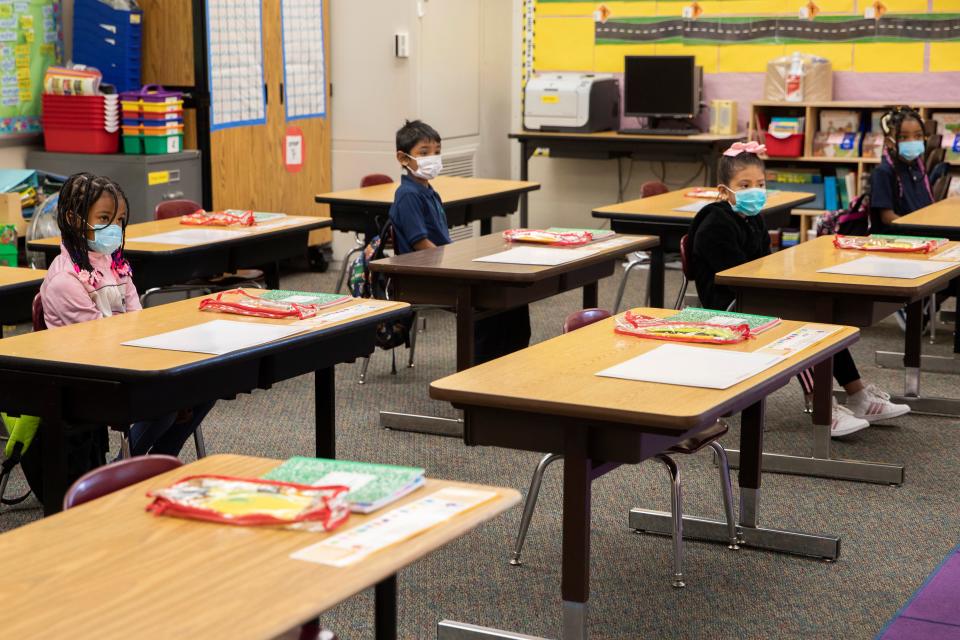Parents of Black and Hispanic kids more hesitant on in-person school. Show them it's safe.
Racial achievement gaps have plagued American education for decades. Not only are they large, they have proved persistent despite the thousands of programs and millions of dollars devoted to closing them. This year, even worse than lack of progress, racial achievement gaps have grown: Students of color are projected to be six to 12 months behind academically due to COVID-19, compared with four to eight months for white students.
While the durability of pre-COVID achievement gaps is mostly a consequence of their complex causes (causes often beyond the control of schools and teachers), their growth during the pandemic is clearly the result of what has happened — or, more accurately, what hasn’t happened — in schools.
Access to in-person learning has differed considerably by student race. According to the American Enterprise Institute’s Return to Learn Tracker, at the height of this school year’s school closures in early January, half of Black and Hispanic students were in fully remote districts, compared with a third of white students. Districts have steadily returned to in-person instruction, but that return has been significantly slower for black and Hispanic students than for white students.
The other half of the story
Disparities in the availability of in-person instruction are only half of the story, however. The other half lies in who chooses to return when schools reopen. Polls show parents of color consistently prefer remote-only instruction for their students, with gaps between white parents and parents of color ranging from 15-30 percentage points between November and March.
Across the nation, returning students reflect this pattern. When Chicago schools reopened, two in three white students opted to return in person, while just one in three Black and Hispanic students did. Similar divides have been observed in New York City, Washington D.C., and Nashville.

Crucially, the two sides of the story — families’ access to open schools and their hesitancy to return — are strongly related. According to a new analysis of Understanding America Survey data, the single best predictor of whether parents are willing to send their children back to schools is whether their own school reopened. That’s right, districts’ decisions to reopen schools could shape their parents attitudes on reopening schools as much as they are shaped by them. This means that districts have a more profound influence on actually returning students to classrooms than previously thought.
If families of color continue to opt out of in-person learning at higher rates — including next fall when full-time in-person schooling (hopefully) becomes the default — the pandemic-fueled growth in achievement gaps will continue. To avoid that, education leaders need to act decisively and act now to reopen schools for all students and — even more challenging — persuade parents to trust that in-person learning can be done safely. Building that trust requires a three-pronged approach.
Former CDC chief: Think outside the box to offer COVID vaccines where they're needed most
First, reopen confidently and learn from the schools that have made in-person learning work. When states and districts take reluctant steps to reopen schools and when plans become bogged down in collective bargaining, parents may naturally doubt that reopening is safe. Confident decision-making, cogent mitigation strategies and clear communication are essential to building trust with parents when time is of the essence.
Show that schools can reopen safely
Second, reopen as soon as possible. With vaccine availability high and the risks to students low, there are few justifiable excuses for continued delay. The more time families have to become accustomed to in-person schooling — not just nationally but also in their own communities — the more comfortable they will become returning their kids to the classroom. This applies not only to the 6% of fully remote districts, but also to the 50% of districts that are not yet fully opened and continue to keep students out of classrooms. The longer districts normalize unreasonable risk aversion, the longer parents will unreasonably avert risk. Districts can break this cycle: Open the schools first, and the families will come.
Third, and most important, show — don’t just tell — parents that schools are safe. It requires zealously sticking to mitigation strategies that keep students, teachers and their families safe. None of the gains in returning students to the classroom will last if lax operations result in avoidable COVID-19 cases or disruptive quarantines. At the same time, nothing will be more convincing to parents than a clear track record of safe operations in local schools.
Return trip to normal: Don't call it a vaccine passport. It's a ticket to life after COVID.
The nation’s schools are heading in the right direction, and now is not the time to throw caution to the wind. But neither is it the time to back down on the real goal of getting all students back in classrooms, especially students of color who have been — and continue to be — left behind. More than ever before, the decisions school leaders make this year, and this month, will shape the size of the achievement gaps we will face for years to come.
Vladimir Kogan is an associate professor of political science at the Ohio State University. Nat Malkus is a resident scholar and the deputy director of education-policy studies at the American Enterprise Institute.
You can read diverse opinions from our Board of Contributors and other writers on the Opinion front page, on Twitter @usatodayopinion and in our daily Opinion newsletter. To respond to a column, submit a comment to letters@usatoday.com.
This article originally appeared on USA TODAY: Convince Black and Latino parents that in-person school is safe

